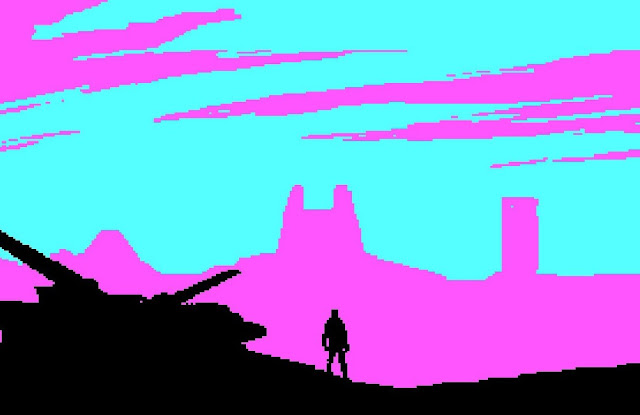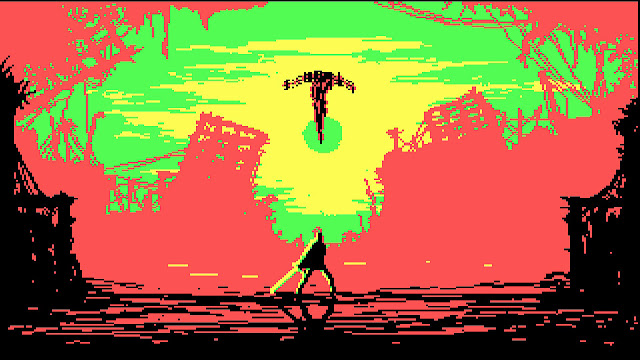Review by Matt S.
I’ll never finish The Eternal Castle. The level of skill that it demands of the player is so far beyond what I’ll ever be able to do that I know, right now and without a shadow of a doubt, that it would be simply impossible for me. But I also wouldn’t have it any other way. This game’s brutality is so completely critical to the theme, atmosphere, tone, narrative and experience that I’d almost be disappointed if I could finish it. In a perverse way, being unable to finish The Eternal Castle makes it so much more effective as one of the finest examples of game art I’ve played in recent years.
To get to why The Eternal Castle has had such an impact on me, I’m going to start with a digression to talk about theatre and, specifically, a man named Antonin Artaud. Now, unless you’re going to study theatre, Artaud isn’t a name that is going to be familiar to you, but this man was intensely important to the way critics (not reviewers, but people that write about the arts) think about theatre and, by, extension, the arts as a whole. Artaud is particularly well known for two works: The Theatre and its Double, which is a collection of essays that essentially lay down on paper Artaud’s entire philosophy, and A Jet of Blood – a play that makes that philosophy abundantly clear.
In The Theatre and its Double, Artaud wrote: “The theatre will never find itself again except by furnishing the spectator with the truthful precipitates of dreams, in which his taste for crime, his erotic obsessions, his savagery, his chimeras, his utopian sense of life and matter, even his cannibalism, pour out on a level not counterfeit and illusory, but interior. […] If theatre wants to find itself needed once more, it must present everything in love, crime, war and madness.”
This… this game is a brilliant bit of game art #NintendoSwitch pic.twitter.com/gHR6VQANoC— Play Final Fantasy VII Remake. For Jessie. 🇯🇵 (@MattSainsb) May 17, 2020
Effectively Artaud’s Great Idea was that he wanted to attack theatrical convention and the structures that traditionally hold it together. He believed that audiences can become complacent with the form of the medium and rejected any theatre that enables that to happen as an inferior quality of art. Were Artaud around now (and if he played games and watched Marvel films) he would have been deeply offended by what mainstream video games and Hollywood cinema has become, because in all cases those creations have been decided to pacify further an already compliant audience.
Artaud was a transgressive, in other words. Indeed, he’s generally identified as the leading mind in transgressive art, along with the likes of Dali, Sade, Foucault and Bataille. It’s not that these people necessarily want to offend, as we often associate with the word “transgressive,” though that’s often a consequence of their willingness to challenge norms and the comfort of the audience (and in some cases, such as Sade, the intent very much is to offend). Rather transgressives reject comfort and mindless consumption of art. They want to force audiences to think and, through thinking, understand better what they are experiencing.
This philosophy led Artaud to pen A Jet of Blood – or Spurt of Blood in some translations – a play that barely counts as a skit in terms of length, and is somehow the most brutally intense thing you’ll ever read. It’s almost impossible to find a performance of it, because it’s almost impossible to actually perform, but you can read it here. I’m not going to even try and deconstruct it in this review, as it’s a couple of weeks of lectures and tutorials that will hurt your brain (I know from when I studied it), but the point I’m driving at here is The Eternal Castle is a game that Antonin Artaud may have produced if he were around today and making video games.
In its most basic form The Eternal Castle is a sidescrolling retro-style platformer that people who have played Flashback or Another World will find superficially familiar. You move from one static screen “room” to the next, solving puzzles, dealing with enemies, and slowly making progress through a violently difficult world that is hostile on every level to your existence.
What immediately distinguishes it from Flashback, and any other side-scrolling platformer you’ll ever play, is how surreal it all is. Transitions from one screen to the next are frequently of the most jarring sort. For example, you’ll be exploring a haunted mansion for a short time, only to be dropped into a science fiction-stylised bunker a moment later. The colours that the game uses are consistently off, and events happen that often feel unrelated to what happened immediately before and after. The game is also deliberately obtuse with the text, to the point of using almost unreadable text at times, and you know that it’s a deliberate aesthetic choice because, at other times when it suits the game, the font is perfectly legible. That illegible text contains some pretty important information… including why you’re on the quest at all. Antonin Artaud hated such mundane ways of conveying information too, and just like A Jet of Blood, the point is almost to not understand what’s going on as you play. It’s somehow more intimately engaging that way.
It’s not just the text where meaning is confused, either. The Eternal Castle features some truly gorgeous retro-style renders that make the game look and feel like something out of the ’80s. However, the developers have also used that as a way of impeding progress at times, making it difficult to see key details in the surrealistic, extreme-contrast environments. At least some of brutal difficulty comes from this; the pacing of the game is such that every time you take a moment to get your bearings, you’re almost certain to have something nasty jump out and ruin your day. There were times that I even completely overlooked the small and hard-to-see mercies of the “meditation spots” which you can use to recover health. Through all of this, The Eternal Castle sets a relentless, pulsating, violent pace. One that almost never lets you breathe, and even denies you moments to celebrate your successes since the pace continues anew almost immediately. This game isn’t just evocative on the senses – it’s a rending, powering assault on them, and, yes, it is difficult to play, but not only because it challenges your ability to play games, but because everything about it is so overwhelming in its excesses.
You’ll start to question everything as you play The Eternal Castle. You’ll question the logic and reality of the in-game world because it seems that with every step reality is fluid and indistinct. The logic is somehow warped, the truth of space, physical state of being, colour and texture are all indeterminate. And those little snippets of narrative that you do pick up reference dreams, or portend to things that you’re about to do. Almost as though you’ve already done them and you’re reading back your own account. So there’s no solid sense of time or linearity through narrative either. It is all so utterly confounding that it is also utterly compelling, and just as I’m about to type that I wish that there was an “easy mode” so that I can experience it all, I catch myself, because I also firmly believe that I’m getting the better experience by not being able to finish the game. It’s yet more about The Eternal Castle that I simply cannot be certain about, and that’s where the game derives its power.
Even the marketing of this thing plays up to a very Artaudian approach to art. The Eternal Castle [Remastered] claims to be a remastered version of a highly obscure, “lost” game from the ’80s. The Internet sleuths played right into that by digging deep to discover that there is almost certainly no The Eternal Castle original. This game truly has made people question absolutely everything about the reality that it exists within, and it’s a pure kind of engagement that I find myself yearning for too often in this industry.
Is The Eternal Castle for everyone? By Jesus H Christ, no it is not. Transgressive art stops being transgressive the moment it becomes “for everyone,” by definition. The whole point of transgression is to shock you out of complacency and that isn’t always comfortable. The obvious example there is any transgressive artwork that offends people since that has clearly made them uncomfortable. The Eternal Castle isn’t ever offensive, but it will certainly make you uncomfortable. Instead of relying on something as relatively mundane as causing offence, the developers have instead done everything to challenge the senses and everything we understand about video games. Right down to the very idea that a game’s value can be found in completing it. I’ll never finish The Eternal Castle, and I think that that is simply magic. I truly love that the game is so utterly and completely happy to do that to me.
– Matt S.
Editor-in-Chief
Find me on Twitter: @mattsainsb
The critic was provided with a review code for the purposes of this review.










